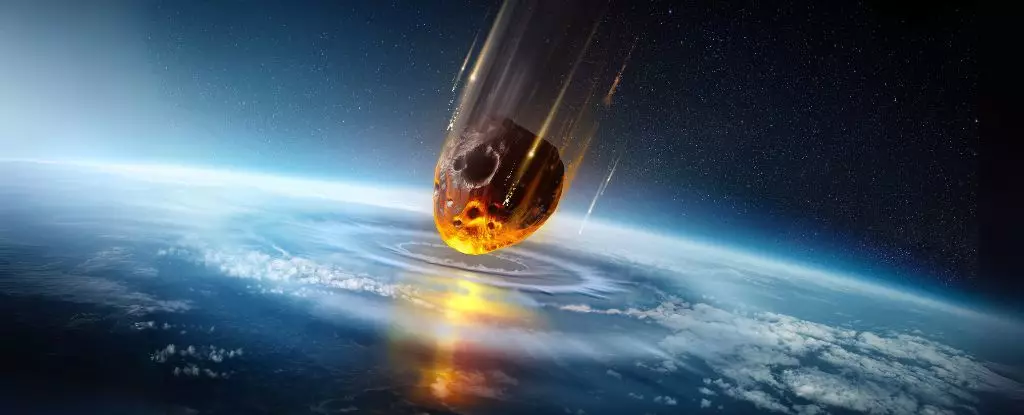Throughout Earth’s tumultuous history, catastrophic impacts have often been seen solely as agents of destruction—mass extinctions, climate upheavals, and planetary reset buttons. However, emerging research challenges this narrative, revealing that some of these fiery encounters may also serve as cradles for life. The recent groundbreaking findings from the Lappjärvi impact structure in Finland demonstrate that, contrary to longstanding assumptions, asteroid impacts could have facilitated the emergence and persistence of microbial life within the fractured, heated zones beneath impact sites. This reframing pushes us to appreciate impact craters not just as scars on the planet’s surface, but as potential hotspots for biological innovation.
The Lappjärvi impact event, dating back 78 million years, laid waste to a vast region, creating a complex underground hydrothermal system. Earlier models framed these systems as transient and inhospitable, extinguished once the intense heat dissipated. But the new evidence suggests that these zones could have persisted longer, providing niches where microbial communities could establish a foothold. This discovery compels a reevaluation of impact events: rather than purely destructive phenomena, they might serve as crucibles for life’s resilience and adaptation.
Microbial Life Finds a Way in Fractured Bedrock
The crux of this scientific breakthrough hinges on microbial activity evidenced through sophisticated isotopic analysis. Researchers identified signatures of sulfate-reducing bacteria—microbes that breathe sulfate instead of oxygen—deep within fractured mineral veins of the impact site. These microbes use organic materials and sulfate to sustain themselves, producing hydrogen sulfide in the process. Crucially, the geochemical signatures, including distinctive sulfur isotope ratios, reveal that microbial activity commenced roughly 74 million years ago, shortly after the impact event.
This precise dating overturns previous hypotheses that microbial colonization in impact zones occurred only much later due to environmental stabilization or other factors. Instead, the data imply that life was already thriving within the fractured, mineral-rich environment about 10 million years after the impact, as temperatures declined from their initial scorching levels. The presence of carbonate minerals associated with microbial sulfate reduction further strengthens this case—signatures that microbes had established a long-term foothold within these underground landscapes.
The significance of this finding extends beyond mere existence. It suggests that impact-generated hydrothermal systems offered habitable conditions, with temperatures conducive to microbial life, as early as 47°C. Such environments, often dismissed as too extreme, are now recognized as viable biological habitats, at least for microbial organisms. The impact craters, often seen as catastrophic scars, emerge as potential catalysts for life’s inception in Earth’s primordial environment.
Implications for the Origin and Distribution of Life
The broader implications of this research ripple into our understanding of life’s origins on Earth—and potentially beyond. Impact events are known to deliver prebiotic building blocks such as amino acids and other organic molecules, possibly seeding life across planetary systems. This new evidence elevates impact craters from mere repositories of destruction to possible incubators of life, especially in planetary bodies like Mars, where impact processes are abundant.
If microbial colonization can occur swiftly within impact structures, then such zones might have been critical staging grounds during Earth’s early history, providing refuges where life could survive harsh conditions or rebound after global catastrophe. Moreover, impact-generated hydrothermal systems could have served as natural laboratories for chemical evolution, fostering complex organic chemistry and early metabolic pathways necessary for life.
This insight also holds profound relevance for astrobiology—if microbial life can endure within impact zones on Earth, similar prospects exist for other planets and moons. The possibility that impact craters on Mars or icy moons like Europa could harbor or have once harbored life underscores the importance of targeting these regions for future exploration. They are not just scars of violent cosmic events; they are potential signposts of the universe’s life-creating potential.
Challenging Assumptions and Embracing Complexity
What remains particularly compelling is how this research exposes the limitations of our previous models. For decades, the scientific consensus has often painted impact craters as solely destructive aftermaths—temporary inhospitable zones that reset the biosphere. Now, the evidence from Lappjärvi demonstrates that even in the face of catastrophe, life finds a way—not simply surviving but actively exploiting newly formed environments. This resilience challenges us to consider the nuanced role of impact events in planetary evolution.
Furthermore, the innovative use of isotopic biosignatures exemplifies the power of cutting-edge techniques in unraveling Earth’s hidden history. Direct geochronological evidence linking microbial activity to impact events has remained elusive until now, making these findings a paradigm shift. They underscore the importance of integrating geochemistry, microbiology, and planetary science to build a holistic picture of life’s potential pathways.
As we look toward future research, it’s evident that impact structures should be studied not only for planetary geology but also for their biological potential. These zones might serve as natural laboratories for understanding how life can emerge, adapt, and persist in extreme environments—insights that could be invaluable in the search for extraterrestrial life. In this light, the scars of cosmic collisions are transformed from destructive wounds into promising portals for cosmic understanding and life’s enduring legacy.


Leave a Reply